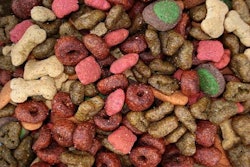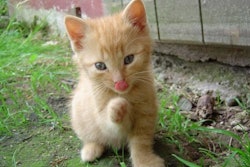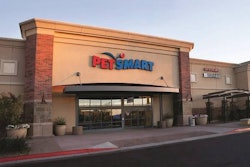The 2014 Pet Obesity Study by the Association for Pet Obesity Prevention (APOP) reports that an estimated 52.7% of dogs and 57.9% of cats in the US are overweight or obese. This is equivalent to nearly 100 million pets! What is even more alarming is that 95% of the owners of overweight dogs and 90% of the owners of overweight cats believe that their pets are actually at a normal weight.
A pet is considered to be obese when the body weight is 30% greater than normal. While this sounds like a tremendous amount, consider that a cat that should weigh 10 pounds is obese at 13 pounds and a 40-pound dog is obese at 52 pounds. To an untrained eye, this may be difficult to recognize, particularly when the weight gain is gradual and when a pet has a fluffy hair coat.
Obesity is harmful to the health of pets. Carrying extra weight puts stress on the joints and can lead to pain and decreased activity. In some breeds of dogs, this excess weight can contribute to orthopedic problems such as ruptured cruciate ligaments in the knees and disk disease in the back. These problems require surgical correction, and recovery is more difficult because of the extra weight the dog is carrying.
In overweight cats, diabetes is a relatively common diagnosis. Just like overweight humans, overweight cats can develop diabetes that is responsive to weight reduction and dietary management. These cats may not require insulin therapy once their weight is decreased.
Certain types of cancers are also seen more commonly in overweight pets than those at a healthy weight. Shortened life spans are yet another possible result of carrying that extra weight.
So, what is the best approach to managing a pet’s body condition? The first step is accepting that a healthy pet may actually appear “skinny” and that it can be easy to put those blinders on to the actual body condition of a pet. Since pets rely on their owners for all of their nutrition, owners are ultimately responsible for the condition of their pets, but pet food companies can help. With regulations requiring calorie content to be included on pet food packaging, it is easier for pet owners to know exactly how many calories are being consumed on a daily basis. Offering quality alternatives to energy-dense diets for those pets that really do not need extra calories is something that most companies are doing today.
Modification of the diet, along with increased activity, should help a pet return to a healthier condition in short order. Ernie Ward, DVM, founder of APOP, points out that one pig ear is equivalent to a six-pack of sodas, so a daily pig ear is adding a lot of unnecessary calories to a dog’s diet. Treats do not need to be eliminated, but smart choices need to be made, especially when a pet needs to lose weight.
One of the challenges often faced with low-fat, high-fiber weight loss pet diets was poor palatability. However, these diets are often very effective at promoting weight loss, and many pets will eat them without any trouble. Foods made with high protein and moderate fat content will help pets lose weight without as much trouble with palatability. The high protein content will promote the sparing of muscle tissue during the weight loss process and will force the pet’s body to burn fat for energy. Added L-carnitine, a vitamin-like nutrient, promotes metabolism of fat for energy and protects the health of the liver. This nutrient also helps regulate blood sugar levels, an important benefit for overweight cats.
Once ideal body condition is achieved, continuing with a lower fat food and exercise will help maintain that beautiful new body!
APOP has a great website with tools for helping pet owners achieve ideal condition for their pets.
















